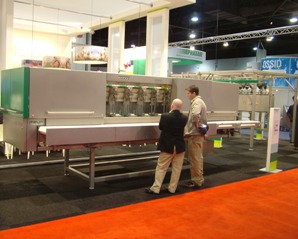Focus on food safety and quality at IPE

Traditionally, poultry processing plays an important part at the International Poultry Exposition (IPE) in Atlanta, USA. Also at this year’s edition, which took place in the last week of January, much attention was paid to topics in this field. Several scientific and educational meetings focused on improving quality and food safety. In addition, so did exhibiting companies.
By Dr. Roel Mulder, Spelderholt Poultry, Epe, the Netherlands
During the International Poultry Scientific Forum (IPSF) prior to IPE over 250 papers and posters were presented to more than 600 participants. Moreover, there were special conferences and workshops such as the Salmonella and Campylobacter reduction conference. At the ISPF it was striking to note that more papers were presented in the Processing and Products session than in the years before.
Subjects like general meat quality, quality of further processed products, effect of packaging materials on quality and safety of stored products, the presence of Salmonella, Campylobacter and Listeria monocytogenes as influenced by primary and further processing, were discussed. Aspects of water and energy use in poultry processing were also tackled.
Chilling for food safety
At IPE major companies showed their latest developments. Most recently, developments on scalding and stunning of broilers and chilling of carcasses were considered important. Aspects of animal welfare, hygiene and food safety, water and energy saving, dominated in the design of equipment that should be able to process up to 12,000 broilers per hour, on one line. It seems, however, that in several parts of the world there also is a growing market for processing lines able to process 500 to 3,000 birds per hour, away from the enormously high capacities.
Chilling of carcasses plays an important role in food safety, but also is important in energy and water saving practices. Air chilling is a good alternative to immersion chilling. It minimises cross-contamination, protects natural flavour and it results in higher yields and a prolonged shelf life of the products, whether sold as whole carcasses or as portions. With regard to survival of Campylobacter the use of air-chilling is beneficial (the bacterium does not like cold and oxygen), providing a faster and dryer cooling down. This type of chilling is widely used in Europe.
The Campylobacter problem, however, has not been solved by its use. As water and energy reduction programmes have become more important, alternatives to the traditional, widely applied, chilling of carcasses in water have been developed. At the show, amongst others, Morris & Associates showed their large immersion chillers, and TopKip showed their successful “Combi in-line air chilling system”, which significantly reduces water and energy costs and results in a longer shelf life of the products and additionally allows 100% tracing and tracking of individual carcasses, which is an increasingly important quality aspect.
| All the major suppliers of processing lines attempt to achieve high accuracy at high speed. | According to Morris, their JetBird chiller is minimising Salmonella counts. |
Efficiency of operation
Traditionally, developments in the area of portioning and deboning are presented by all major companies. Examples were presented by Meyn, Stork Marel, Foodmate and LincoBaader. Generally speaking, excellent cutting accuracy in this equipment is achieving more yield at higher speeds (7000 breasts or 2000 legs per hour). Food safety and hygienic design are key issues in the development and design of this equipment.
Because of the high speeds of processing, an efficient cleaning and disinfection of the equipment during and after processing hours is becoming increasingly more important. Also trends for a complete controllable slaughtering process were visible. The use of sensors, cameras and robots will contribute to the efficiency of operation and will have a positive effect on the quality of the products. Software used for process control also allows full traceability.
Cooking parameters
Further processed products such as batter and breaded, grilled, marinated and roasted products have become more important. For every product, specific procedures are needed with regard to the cooking process, in terms of yield, browning, texture and juiciness. Equipment should be flexible in managing the temperature, the air speed and relative humidity in the ovens. All products should be cooked to be safe, have a uniform quality and a high yield.
Multiple zone cooking is applied in the CFS Cookstar equipment, which can be used for steaming, cooking and roasting. In every zone, temperature and relative humidity can be programmed for optimum product quality. Generally speaking the equipment for these types of products has improved considerably over the last years and all major companies have contributed, in order to give the possibility for using the correct cooking parameters to achieve optimum yield, quality and safety.












